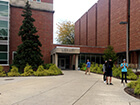
View slideshow.
Association of Research Libraries (ARL) executive director Elliott Shore has embarked on a “listening tour” of ARL member libraries to see first-hand the innovative work the libraries are doing and to learn how the Association can better serve its members. This is the 13th in a series of informal reports from his visits.
On October 17–20, 2016, I visited the three ARL member libraries in Michigan—Michigan State University, University of Michigan, and Wayne State University. I spent a full day on each campus, touring and talking with library staff and administration. Each institution wanted to hear how the Association is implementing its System of Action. I updated everyone on the work of the Coordinating Committee to implement the IdeaScale platform for crowdsourcing project ideas from the membership and described projects in the pipeline.
My visit began on the afternoon of October 17 at Michigan State University Libraries with a tour by director Cliff Haka of their Remote Storage and the Main Library. Cliff hosted me and the library administrative team for dinner at his home that night. The next morning I made a presentation to library staff. That was followed by tours and discussion of key initiatives, such as the Rovi Media Collection and the Turfgrass Information Center, punctuated by lunch with Cliff and the administrative team. The Rovi Media Collection—one of the largest publicly accessible media collections in the world with nearly 700,000 music CDs, more than 160,000 DVDs, and over 17,000 video games—was donated to the libraries in March 2015 by the Rovi Corporation. The Turfgrass Information Center is the world’s most comprehensive publicly available collection of turfgrass research and educational materials. I was struck by two interrelated issues: the sheer size of the Rovi collection and how it caused an impressive rethinking of the storage, retrieval, and circulation of materials that are of enormous interest both to scholars and the general public.
On October 19, my day at University of Michigan kicked off with a tour of the Digital Media Commons at the Duderstadt Center on the North Campus, which serves the engineering, art, dance, theater, and architecture faculties. Digital Media Commons co-director Eric Maslowski and I viewed the array of state-of-the-art labs that the commons houses and imagined how one might bring all of the disparate facilities together. The tour was followed by three one-on-one meetings with: Mike Furlough, executive director of HathiTrust, during which we thought about how we could collaborate better among the signature projects that undergird our digital future; Nerea Llamas, head of international studies for the library, about research data services; and Jeff Witt, diversity and inclusion specialist for the library, about using the library’s strategic plan for diversity as a model for the campus. Jeff and I surmised that Michigan might be the only ARL library with both a full-time diversity officer and a full-time accessibility officer. I enjoyed lunch with Charles Watkinson, Mary Francis, Becky Welzenbach, and Jeremy Morse, all of Michigan Publishing, which includes the university press and is part of the library. We discussed next steps in the Association of American Universities (AAU)/ARL Task Force on Scholarly Communication’s digital monograph project. After lunch I gave a talk to all library staff, not only about the projects coming out of ARL now but also how the University of Michigan might be an active partner with ARL. Then, library dean James Hilton and I had a conversation with the staff that drilled down more deeply into the ways in which ARL and Michigan could collaborate. The day concluded with a meeting with the Library Executive Council, in which we discussed key points from the day’s sessions.
Wayne State University Libraries dean Sandy Yee and I spent all of October 20 in a variety of contexts, meeting with various combinations of library staff. Each of our conversations focused on how to improve the already strong connections between the library and the university’s mission. After a short meeting with Sandy and associate dean Tim Gritten, I attended a Library Leadership Team meeting, where I presented a brief overview of the ways in which ARL’s System of Action functions. I then met with assistant dean Paul Gallagher, assistant director for discovery and innovation Elliot Polak, and the Library Publishing Team. We discussed in some detail how a project centered on SHARE could be a tool the library could leverage to meet Wayne State’s priorities in research and publication. Stephen Bajjaly, associate dean and professor in the School of Library and Information Science, led a meeting with the faculty in which we explored the possibilities inherent in Wayne State’s unique position as the only ARL library where the library school dean and the dean of the libraries are one and the same. We also focused on how a library school could be more effective in preparing its graduates for work in our libraries. The highlight of the day was the get-together that Sandy and I had with the provost, Keith Whitfield, who had arrived from Duke University a short six months before. We discussed in depth the ways in which an ARL library can partner throughout the institution to further university-wide goals through such initiatives as SHARE, the AAU/ARL monograph project, and connecting academic departments and the library through shared staff.
{loadposition slideshow-elliott-michigan}


